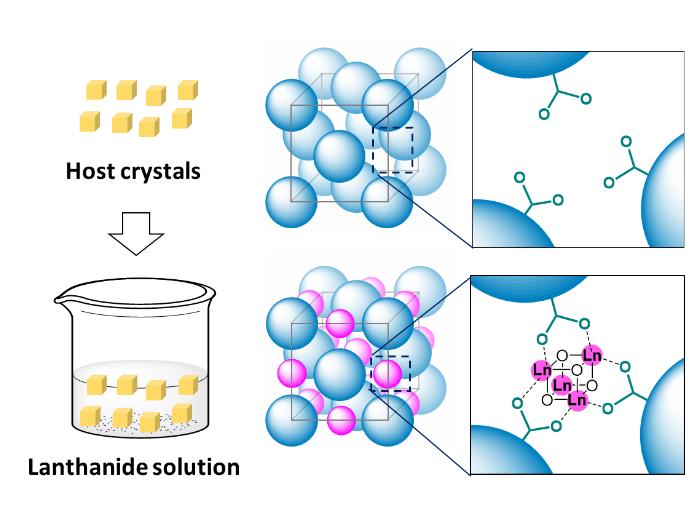Scientists at Osaka University demonstrate a simple method for inserting high-energy cubane molecules into an existing single-crystal supramolecular framework, work that may lead to next-generation energy storage and engineered catalysts

Credit: Osaka University
Osaka, Japan – Researchers at Osaka University have discovered a new method to easily add lanthanide cubanes into a previously synthesized metallo-supramolecular framework. By simply soaking a crystal in a cubane-containing solution, the molecules become intercalated via a single-crystal-to-single-crystal transformation. This research may help chemists design cost-effective methods of storing energy or develop new catalysts.
Once thought too unstable to exist, cubanes are synthetic molecules with atoms arranged to form a cube. The extremely strained right-angle bonds store a great deal of chemical energy, like tightly wound springs. However, once created by chemists, cubanes can keep their shape for a long time. These properties make cubanes attractive candidates for storing energy, as well as for accelerating reactions as catalysts.
Now, scientists at Osaka University have shown how to immobilize cubanes made from lanthanide elements into crystal frameworks. “We discovered a facile synthetic method for lanthanide hydroxide clusters, which may be used as functional materials,” says first author Nobuto Yoshinari.
Lanthanides are a group of chemically similar elements, known to many people for their special section on most versions of the periodic table. The researchers found that by immersing a crystal of K6[Rh4Zn4O(L-cys)12] in a solution containing Ln4(OH)4 (lanthanide hydroxide) cubane molecules, the cubane molecules became attached inside the empty pockets of the crystal without disrupting its structure. A metal-organic framework (MOF) was obtained when using the heavier lanthanides, while the lighter elements yielded ionic solid structures.
“Previously, lanthanide hydroxide clusters have been synthesized under harsh conditions, but our new method requires only the soaking of the host crystals into a lanthanide salt solution at room temperature,” senior author Takumi Konno explains.
The team tested the catalytic activity of the frameworks when speeding up a hydrolysis reaction. They found that the effectiveness of the catalyst depended on which element from the lanthanide series was used. The researchers also measured the magnetic susceptibility of the metal ions inside the frameworks, and found a cooling effect when exposed to a decreasing magnetic fields. The lanthanide hydroxide clusters created inside the crystal framework are expected to be useful for a wide range of applications, including materials for magnetic cooling as well as advanced heterogeneous catalysts.
###
The article, “Single-crystal-to-single-crystal installation of Ln4(OH)4 cubanes in an anionic metallosupramolecular framework,” was published in Angewandte Chemie International Edition at DOI: https:/
About Osaka University
Osaka University was founded in 1931 as one of the seven imperial universities of Japan and is now one of Japan’s leading comprehensive universities with a broad disciplinary spectrum. This strength is coupled with a singular drive for innovation that extends throughout the scientific process, from fundamental research to the creation of applied technology with positive economic impacts. Its commitment to innovation has been recognized in Japan and around the world, being named Japan’s most innovative university in 2015 (Reuters 2015 Top 100) and one of the most innovative institutions in the world in 2017 (Innovative Universities and the Nature Index Innovation 2017). Now, Osaka University is leveraging its role as a Designated National University Corporation selected by the Ministry of Education, Culture, Sports, Science and Technology to contribute to innovation for human welfare, sustainable development of society, and social transformation.
Website: https:/
Media Contact
Saori Obayashi
[email protected]
Original Source
https:/
Related Journal Article
http://dx.




